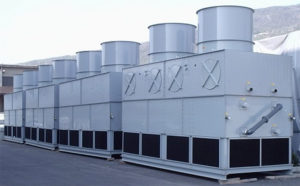Towers and exchangers: the evaporative condenser
Let’s finish the section dedicated to the selection of cooling towers with a particular type of thermal machine, the evaporative condenser. Evaporative condensers combine the advantages in terms of efficiency provided by tower’s evaporative process, with those that characterizes heat exchangers.
An evaporative condenser is obtained when the filling pack within a cooling tower is replaced by a coil exchanger, upon which the water falls after a pump has provided its recirculation. The liquid to be cooled and condensed flows inside the exchanger, giving up its heat to the water that flows on the external surfaces of the coil exchanger. Thanks to evaporation, the falling water removes a higher amount of heat compared to the heat that could be dissipated leveraging thermal transfer to further water at the liquid state. Heat dissipated through water vapour production is indeed higher than the heat amount that must be supplied in order to warm up an equal amount of water. And this is due to the physical behaviors of many fluids when they pass from liquid to gaseous state.
In this case the speed of the fluid must be carefully controlled, because if the fluid is flowing too fast it will compromise the correct evaporation process, due to the drag effect of condensate droplets.
An evaporative condenser can have the same shape of an evaporative tower, and offering a thermal transfer process which is based on water evaporation its performances are as well related to air ambient conditions, to dry bulb temperature and wet bulb temperature. The lower the ambient air humidity level, the higher will be the amount of vapor coming from the condenser that ambient air will be able to absorb. Fans are often employed with exchangers used in function of condensers, moving high amounts of air and scattering the water vapor generated by the condenser.




 Back to index
Back to index Download the complete book
Download the complete book